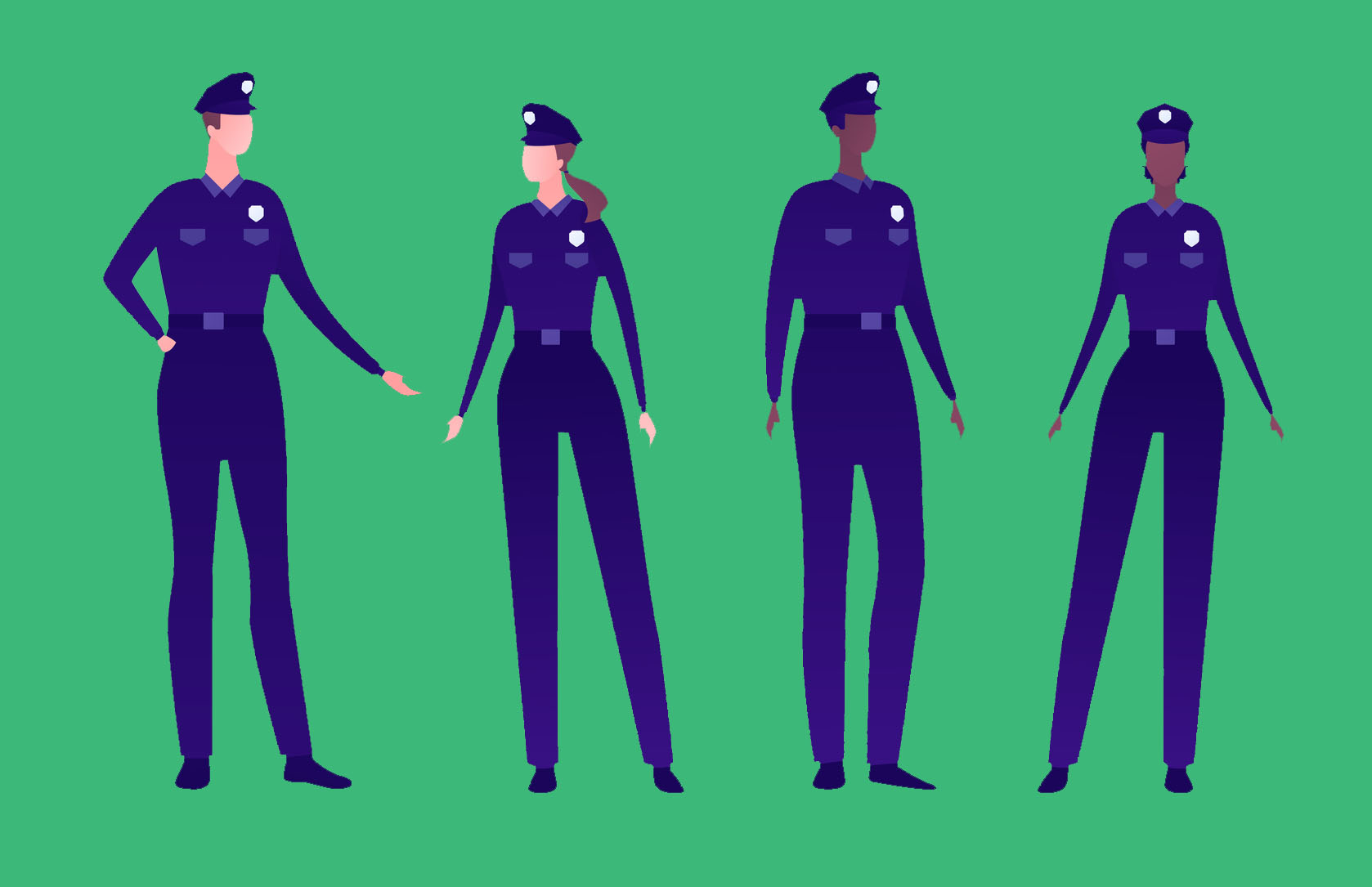Contact Us
To provide feedback on the Community Policing Dispatch, e-mail the editorial board at CPDispatch@usdoj.gov.
To obtain details on COPS Office programs, publications, and resources, contact the COPS Office Response Center at 800-421-6770 or AskCopsRC@usdoj.gov

U.S. Department of Justice
Office of Community Oriented Policing Services
Washington, DC 20530
Whether policing a small unincorporated village or a major urban metroplex, law enforcement professionals will meet people with trans or non-binary gender identities. Many agencies that strive to have their employees reflect and represent the communities they serve now have outreach programs designed to recruit and hire from within minority gender identities, as they would from other minority groups. Many agencies already have trans and non-binary officers and support personnel. However, in most organizations, uniform and grooming standards still only reflect the gender binary of male and female.
Gender-neutral uniform standards avoid forcing non-binary employees into an identity not their own. In addition, they allow for easy accommodation of the body morphology changes many people of all genders may go through during their careers. For cisgender personnel (those whose assigned sex at birth matches their own sense of gender identity), those changes could be the result of physical injuries, illness, or aging, and may include such procedures as radical mastectomies and other cancer surgeries, weight losses and gains, medications, reconstructive surgeries, and body changes due to weight training or other intense forms of athletic training. For transgender personnel transitioning on the job, those changes may include surgery that reshapes the chest and hormone replacement therapy that can affect the shape of the entire body.
 Gender-neutral grooming standards also permit employees of all genders to present in a way consistent with their identity while also maintaining the consistency of a uniformed public presence. For personnel transitioning, whether to a binary or non-binary identity, gender-neutral grooming standards allow for changes in hair length, facial hair, and other aspects of personal presentation. Some organizations have already adopted gender neutral uniform and grooming standards, including the Portland (Oregon) Police Bureau, the Sacramento (California) Police Department, and the Washington, D.C. Metropolitan Police Department. Many law enforcement organizations are also considering the move to gender-neutral bathrooms, locker rooms, and changing rooms.
Gender-neutral grooming standards also permit employees of all genders to present in a way consistent with their identity while also maintaining the consistency of a uniformed public presence. For personnel transitioning, whether to a binary or non-binary identity, gender-neutral grooming standards allow for changes in hair length, facial hair, and other aspects of personal presentation. Some organizations have already adopted gender neutral uniform and grooming standards, including the Portland (Oregon) Police Bureau, the Sacramento (California) Police Department, and the Washington, D.C. Metropolitan Police Department. Many law enforcement organizations are also considering the move to gender-neutral bathrooms, locker rooms, and changing rooms.
Officer safety is also a high priority and concern for law enforcement organizations. Wearing a uniform that isn’t well fitted can be deadly; gender-neutral uniform standards, by allowing for body changes, can help ensure that uniforms allow freedom of movement and a full range of motion. Two priorities in uniform fit should be the reduction of irritations such as chafing and binding at necklines, sleeves, bust lines, and waistlines, and restricted motion in shoulders and leg stride caused by too tight a fit. A too-tight uniform can potentially impede an officer’s ability to apprehend and control a suspect in a physical confrontation; however, the bunching and bagging of too-loose uniforms around the neckline, shoulders, bust line, and waistline can cause snagging or catching on things and can also be gripped by a suspect in a physical confrontation, potentially placing the officer’s life in jeopardy. Officers in well-fitted uniforms are comfortable physically and experience less psychological distress, allowing them to be more confident in their appearance and presentation and better able to do their jobs safely and effectively.
 Confidence in appearance is extremely important, and gender-neutral uniform and grooming standards can help trans and non-binary officers maintain that confidence. Officers in the process of transitioning often end up having to mix and match male and female uniform items and grooming standards to obtain a reasonable fit and presentation in their uniforms. They may experience stages during transition where they cannot easily adhere to either binary gender’s uniform policy or grooming standards. For people transitioning to a binary gender identity, these stages may be transitory—though they may not be. For some binary people, cis or trans, the uniform and grooming standards for their gender may still be difficult or impossible to achieve—for example, gender-non-conforming officers, or very tall women and very short men, who may simply not fit in the size range for their own gender’s uniform pieces. Even if these periods of difficulty conforming to standards are transitory, the officer may still feel self-conscious and uncomfortable at presenting a discordant appearance and may experience intense psychological distress.
Confidence in appearance is extremely important, and gender-neutral uniform and grooming standards can help trans and non-binary officers maintain that confidence. Officers in the process of transitioning often end up having to mix and match male and female uniform items and grooming standards to obtain a reasonable fit and presentation in their uniforms. They may experience stages during transition where they cannot easily adhere to either binary gender’s uniform policy or grooming standards. For people transitioning to a binary gender identity, these stages may be transitory—though they may not be. For some binary people, cis or trans, the uniform and grooming standards for their gender may still be difficult or impossible to achieve—for example, gender-non-conforming officers, or very tall women and very short men, who may simply not fit in the size range for their own gender’s uniform pieces. Even if these periods of difficulty conforming to standards are transitory, the officer may still feel self-conscious and uncomfortable at presenting a discordant appearance and may experience intense psychological distress.
For non-binary officers, that discordant appearance and presentation may be ongoing because neither binary uniform or grooming standard fits the officer’s body or gender presentation. Gender-neutral uniforms and grooming standards can eliminate this issue and significantly reduce psychological distress for both trans and non-binary officers, as well as for cis officers who are temporarily or permanently unable to fit a too-narrow binary standard. Additionally, the peers of all these officers are much more comfortable and find it easier to accept their gender non-conforming members when all are wearing the same uniform and adhering to the same grooming standards. Wearing and presenting in the same uniform promotes a feeling of belonging and a strong sense of esprit de corps.
 Difficulties in adhering to uniform standards, however, are not the only causes of toxic work environments. Trans, non-binary, or gender-non-conforming officers may be ostracized, isolated, treated with disrespect, bullied, addressed by the wrong pronouns or deadnamed (i.e., addressed by a previous name associated with another gender), and denied promotion or training opportunities. Officers experiencing a toxic or hostile work environment without relief will often choose to use civil litigation to rectify the situation when other organizational options have failed. Currently, these litigation actions often end in out-of-court settlements that range from tens to hundreds of thousands of dollars, while court judgements may range in millions of dollars. Those figures don’t include the loss of the tens to hundreds of thousands of dollars spent in training and fielding an officer and providing the required career-long continuing education. Outcomes in civil litigation over toxic or hostile work environments in response to gender transition, gender identity, or gender-non-conformity have consistently favored plaintiffs. This is particularly true in law enforcement, as agencies’ legal teams tend to opt for out-of-court settlements. Negative media attention and the loss of community partnerships within the LGBTQ+ community bring unnecessary and unwanted attention to agencies—all due to an issue that can be easily mitigated. Creating gender-neutral uniform and grooming standards will help in significantly reducing organizations’ potential for litigation and the potential loss of trained law enforcement officers due to their gender identity and presentation.
Difficulties in adhering to uniform standards, however, are not the only causes of toxic work environments. Trans, non-binary, or gender-non-conforming officers may be ostracized, isolated, treated with disrespect, bullied, addressed by the wrong pronouns or deadnamed (i.e., addressed by a previous name associated with another gender), and denied promotion or training opportunities. Officers experiencing a toxic or hostile work environment without relief will often choose to use civil litigation to rectify the situation when other organizational options have failed. Currently, these litigation actions often end in out-of-court settlements that range from tens to hundreds of thousands of dollars, while court judgements may range in millions of dollars. Those figures don’t include the loss of the tens to hundreds of thousands of dollars spent in training and fielding an officer and providing the required career-long continuing education. Outcomes in civil litigation over toxic or hostile work environments in response to gender transition, gender identity, or gender-non-conformity have consistently favored plaintiffs. This is particularly true in law enforcement, as agencies’ legal teams tend to opt for out-of-court settlements. Negative media attention and the loss of community partnerships within the LGBTQ+ community bring unnecessary and unwanted attention to agencies—all due to an issue that can be easily mitigated. Creating gender-neutral uniform and grooming standards will help in significantly reducing organizations’ potential for litigation and the potential loss of trained law enforcement officers due to their gender identity and presentation.
As communities change, so does the pool of recruits entering academies and training classes. Diversity within the community means diversity within the law enforcement organization serving that community. Policies and standards need to be revised regularly to reflect the changing cultures, attitudes, and diversity within communities, as well as to incorporate changes in the law. These necessary changes in policy take time and consideration of their potential impacts on both personnel and the organization itself. This consideration is worth the investment of time and effort. Law enforcement organizations adopting gender-neutral policies and standards are taking giant strides towards balancing the need for a uniformed presence in policing, while at the same time respecting and accommodating the multiplicity of personal and gender identities that diversity brings to any organization.
About TCOPS

The Transgender Community of Police & Sheriffs (TCOPS International) is a law enforcement peer-support and education group on issues relating to gender identity and gender transition in the workplace.
TCOPS members are active duty, retired, and former law enforcement officers and law enforcement support personnel from around the world.
TCOPS International is a private support group, not a nonprofit organization, but does not charge fees for services or experience. TCOPS members act as consultants and advisors to assist public safety agencies and employees, primarily in the law enforcement field.
Subscribe to Email Updates
To sign up for monthly updates or to access your subscriber preferences, please enter your email address in the Subscribe box.






